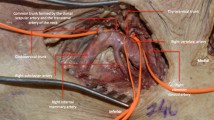Abstract
Utilization of lower trapezius island flap (LTIF) provides an alternative in reconstruction of the select defects in head and neck region. When muscle bulk is needed under the skin paddle, it may be important to know the exact location of the inferior edge of the trapezius muscle (TM) in order to design the skin paddle accordingly. Due to the anatomic variations seen especially in the origin of trapezius muscle, there are no reliable surface landmarks to define the inferior edge of TM. We present a simple ultrasound-assisted technique of identifying the inferior border of TM preoperatively.
Level of Evidence: Level V, diagnostic study.




Similar content being viewed by others
References
Urken ML, Naidu RK, Lawson W et al (1991) The lower trapezius island musculocutaneous flap revisited: report of 45 cases and a unifying concept of the vascular supply. Arch Otolaryngol Head Neck Surg 117:502–511
Nyemb PMM, Fontaine C, Demondion X et al (2017) Morphological anatomy of the trapezius muscle, about 58 dissections: what to know before harvesting the muscular flap. MOJ Anat Physiol 4:348–353
Beaton LE, Anson BJ (1942) Variations in the origin of the m. trapezius. Anat Rec 83:41–46
Can A, Orgill DP, Ulrich JOD, Mureau MAM (2014) The myocutaneous trapezius flap revisited: a treatment algorithm for optimal surgical outcomes based on 43 flap reconstructions. J Plast Reconstr Aesthet Surg 67:1669–1679
Netterville JL, Panje WR, Maves MD (1987) The trapezius myocutaneous flap. Dependability and limitations. Arch Otolaryngol Head Neck Surg 113:271–281
Sadigh PL, Chang L, Hsieh C et al (2014) The trapezius perforator flap: an underused but versatile option in the reconstruction of local and distant soft-tissue defects. Plast Reconstr Surg 134:449e–456e
Author information
Authors and Affiliations
Corresponding author
Ethics declarations
Funding
There is no funding involved in this article.
Conflict of interest
The authors, Emre Vural, MD; Santiago Gonzalez, BS, BA; Mauricio Moreno, M.D.; Teresita Angtuaco, MD; and Donald Bodenner, MD, PhD, declare that they have no conflict of interest.
Patient consent
This article contains studies with human participants. Informed consent was obtained from all individual participants included in the study.
Ethical approval
For this kind of study formal consent from a local ethics committee is not required.
Additional information
Publisher’s note
Springer Nature remains neutral with regard to jurisdictional claims in published maps and institutional affiliations.
Rights and permissions
About this article
Cite this article
Vural, E., Gonzalez, S., Moreno, M. et al. Ultrasound-assisted definition of inferior border of the trapezius muscle in lower trapezius island flap reconstruction. Eur J Plast Surg 42, 391–394 (2019). https://doi.org/10.1007/s00238-019-1500-1
Received:
Accepted:
Published:
Issue Date:
DOI: https://doi.org/10.1007/s00238-019-1500-1




